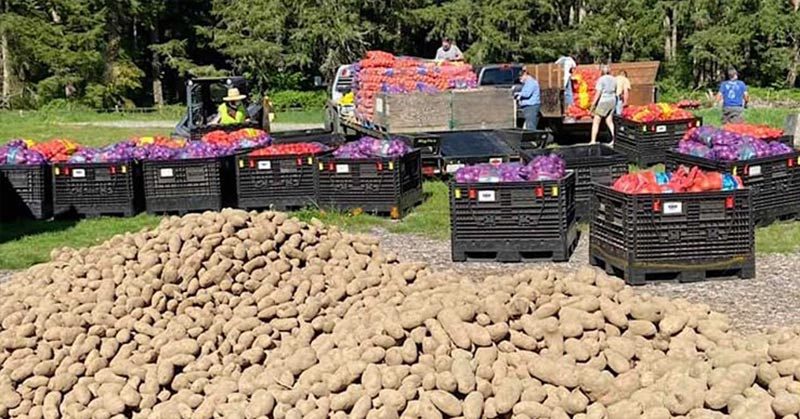When the COVID-19 pandemic began, we witnessed the monumental breakdown of one very important system: our food supply chain. One Washington man saw crops going to waste and decided to do something about it.
The closure of restaurants, schools, and businesses across the country left farmers with a massive surplus of crops and nowhere to sell them, and the increase in demand from food retail locations like grocery stores was not enough to make up for this loss.
As such, farmers across the country were forced to dump thousands of liters of milk down the drain, euthanise thousands of animals, and destroy fields of produce.
Crops Going to Waste No More
When farmers in Washington lost many of their biggest customers during the COVID-19 pandemic, they began to try to hand out their surplus to locals in need, deciding that they’d rather the food get eaten then be thrown away or left to rot in the ground.
George Ahearn heard what these farmers were trying to do, and decided to step in to help out. He contacted a farm from his hometown to find out if they had any produce they were looking to get rid of.
“Owner AJ Ochoa offered five semi-loads (of potatoes),” Ahearn said. “I said, ‘I’ve got a private vehicle, and I can’t take that.’ He said, ‘Just come take what you need.’” [1]
Contacted Food Banks
He then contacted food banks, and although they did want the potatoes, they couldn’t take them if they were loose and not in bags.
He sent out a Facebook message asking if anyone had a truck he could borrow to haul the discarded produce to Western Washington food banks, and the responses quickly came flooding in.
Instead of just one truck, he ended up with a convoy of four trucks, including two with trailers, and managed to bring 9.36 tonnes of potatoes and onions to the food banks, far surpassing his original goal of two thousand pounds.
To solve the issue of packaging them for the food banks, Zsofia Pasztor, founder and owner of Farmer Frog, a nonprofit that allows children and families grow food for themselves, offered crates for the produce, as well as the use of her distribution system that she already had set up with the food banks for the other programs she was running.
The help could not have come at a more crucial time.
“At the time COVID all happened, the 2020 potatoes were all in the ground and the 2019 potatoes were in cold storage,” explained Nancy Balin, one of the original responders to Aheard’s request. “The problem is, when the 2020 potatoes are done, those 2019 potatoes better be gone or there is nowhere for the 2020 potatoes to go.”
For this reason, farmers were faced with the choice of either destroying the 2019 crop, or letting the 2020 crop rot in the field [1].
EastWest Food Rescue
Ahearn, Balin and Pasztor are now the founders and directors of the EastWest Food Rescue, a registered nonprofit that is continuing to deliver discarded produce to food banks. To date, the organization has saved two million pounds of produce from being wasted.
Balin, who is the president of the organization, says that everything happened very organically and took on a life of its own very quickly.
“Now we have a totally volunteer, unpaid staff of about 11 main people who are doing different aspects of it. We have about 500 email addresses and half are volunteers and the other half are donors.” [1]
Much of the monetary donations collected by the organization go toward paying the farmers because Ahearn wanted to make sure that he was simply asking his farming community to give away their products for free.
“We’ll take it if they want to give it away for free, but I always wanted to find out from the farmer what their needs were, what their costs were, and at least try to cover their costs,” he said [1].
Read: Dairy Farmer Bottles His Own Milk Rather than Dump It. Sells Out in Hours
New Season, New Challenges
When the project first began they were dealing primarily with potatoes and onions, but as the summer has gone on the harvest has transitioned to fruit. This presents an even greater challenge, because fruit needs to be refrigerated, and the organization does not have any refrigeration capacity. This also limits their ability to store products like milk and eggs.
“We still don’t have any refrigeration capacity,” said Balin, “so our biggest need besides funds is cold storage, for fruit, milk and eggs.” [1]
The organization’s new goal is to rescue ten million pounds of food, which they estimate will require 250 thousand dollars in donations and hundreds of volunteer hours for packaging and delivery.
Ahearn, for his part, was prepared to stop when the organization reached seventy thousand pounds of food in order to spend more time with his family and his other businesses, but when he saw the communities and the people who needed the help they were providing, he knew he had to continue.
“It has been a wonderful, eye-opening experience about the sheer need that we are experiencing. I am much more attuned to food insecurity issues in our region and in our state.” [1]
To learn more about the EastWest Food Rescue, as well as how to donate or volunteer, visit their website.

